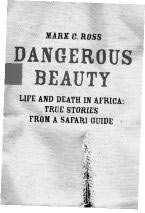DANGEROUS BEAUTY— LIFE AND DEATH IN AFRICA: TRUE STORIES FROM A SAFARI GUIDE
by Mark C. Ross (Talk Miramax Books, $24.95) Third Place Books, 17171 Bothell Way N.E., 366-3333; 7 p.m. Wed., Aug. 22 Elliott Bay Book Co., 101 S. Main, 624-6600; 7:30 p.m. Thurs., Aug. 23
BEFORE CONFRONTING DEATH as a safari guide, Mark C. Ross experienced it as an occasional photographer for The New York Times and other publications that wanted snapshots of Africa’s political malaises. In Dangerous Beauty, Ross’ highly engaging, disturbingly provocative memoir of working in East Africa, the author remembers one assignment that led him inside a dimly lit shipping container in which an ousted Ugandan president’s staff had recently been executed. After fingering the “jagged, knife-sharp edges” of the bullet holes lining the walls, Ross looks down to discover that “this was not mud and oil and dirt I was sloshing through. It was coagulated blood, inches deep.” Pondering this atrocity, Ross decides, “To understand the horror, you have to step inside.”
Except for this incident and the chilling central episode of his memoir, Ross manages to remain outside the horror for the majority of his years in Africa. An Illinois native who fell for the continent after his first visit as an undergraduate biology student, Ross moved to Kenya upon finishing college, and, following short stints teaching in a small village and assisting American journalists, he began orchestrating safaris full-time in 1986.
Writing with an eloquence that’s surprising for someone who spends most of his days seeking large mammals, Ross reveals himself to be an amicable, often headstrong fellow with an infectious enthusiasm for adventure. He’s also a bit of an anachronism in this age of endangered species and environmental depletion (two subjects that make Ross fret for the future), with his wildlife tours that involve campsites complete with queen-size beds and locals toting Western tourists’ cheese rolls. Ross is hardly a colonialist, but one can barely resist associating him with one when he talks about reaching the less-explored corners of the continent: “The knowledge that you are ‘out there’ always makes the place feel special. You can see it in the way locals are transfixed by your presence and by the fact that you see no other white faces anywhere. Every hamlet we drove through was lined with little faces and waving arms.”
But Ross’ memoir is an ode to Africa’s animals, not its people, and the author relates his encounters with these creatures—from the grazing antelope to the stalking cheetah to the dozing leopard—with great reverence. He also details numerous killings, as predators stalk their prey as part of what the author calls a “system” that’s “honed over the millennia and now functioning as smoothly and flawlessly as some over-engineered German sedan.” Some aspects of this system, particularly the annual Grumeti river crossing that has zebras wading into the waiting jaws of crocodiles, seem just as horrendous as humans stepping inside a shipping container to be riddled with bullets. But Ross insists that unlike a human-led massacre, predators feasting on their prey “is the way of that world, and its purpose—simple survival—is pure and blameless.”
HUMAN BLOOD stains Ross’ memoir and reminds the author that, unlike animals, some people are reprehensible for their role in the murders that make up the book’s dark core. In March of 1999, Ross took two Portland, Ore., couples to track gorillas in Uganda’s aptly named Impenetrable Forest. After crossing paths with a group of “pathologically violent and sadistic” Rwandan Hutus intent on collecting a set of international hostages, Ross emerged from the expedition emotionally scarred by the deaths of two of his clients and friends.
The entire tragedy takes up less than a third of this 300-plus-page memoir, yet it taints the rest of it—and not only because it communicates that human beings are capable of far more cruelty than whatever wild beast we’re most afraid of. Ross mentions how many safari-goers almost turn away before watching a cheetah disembowel a wildebeest, but if they don’t flinch, Ross believes, they might “leave those savage scenes with feelings of awe and even respect.” Or, perhaps, the feeling of being entertained. Just before the aforementioned river crossing occurs, Ross notices flesh-hungry crocs slipping into the water and assures his accompanying clients, “It’s show time.”
It wasn’t “show time” for Ross’ stories until he escaped the machete-wielding Hutus. He writes, “Several years ago . . . I wrote a proposal for a book about the life and times of a flying safari guide in Africa.” One assumes publishers didn’t pick up Ross’ memoir until he had a tale more frightening—and more graphic—than fleeing a herd of angry elephants. As a number of tragic-adventure texts (Alive, Into Thin Air, The Perfect Storm) show, dramatic deaths can and do make books best-sellers.
This isn’t to accuse Ross of exploitation. He tells his disturbing story with heartfelt sincerity, and one hopes his writing has brought him the catharsis he deserves. Aside from its literary merit, Ross’ memoir is an exceptional work because it discloses almost as much about its readers as it does its subject. Dangerous Beauty is unsettling proof that what really sets people apart from other animals is our hunger for violence.








